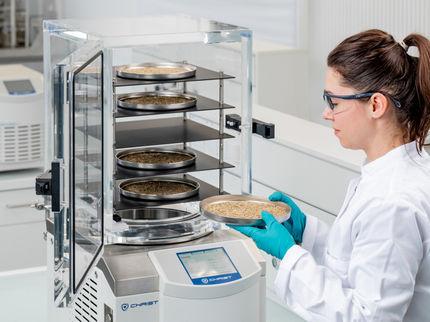Ion channels are pore-forming proteins that help to establish and control the small voltage gradient across the plasma membrane of all living cells (see cell potential) by allowing the flow of ions down their electrochemical gradient. They are present in the membranes that surround all biological cells.
Basic features
Ion channels regulate the flow of ions across the membrane in all cells. It is an integral membrane protein; or, more typically, an assembly of several proteins. Such "multi-subunit" assemblies usually involve a circular arrangement of identical or homologous proteins closely packed around a water-filled pore through the plane of the membrane or lipid bilayer.[1] The pore-forming subunit(s) are called the α subunit, while the auxiliary subunits are denoted β, γ, and so on. While some channels permit the passage of ions based solely on charge, the archetypal channel pore is just one or two atoms wide at its narrowest point. It conducts a specific species of ion, such as sodium or potassium, and conveys them through the membrane single file--nearly as quickly as the ions move through free fluid. In some ion channels, passage through the pore is governed by a "gate," which may be opened or closed by chemical or electrical signals, temperature, or mechanical force, depending on the variety of channel.
Biological role
Because "voltage-gated" channels underlie the nerve impulse and because "transmitter-gated" channels mediate conduction across the synapses, channels are especially prominent components of the nervous system. Indeed, most of the offensive and defensive toxins that organisms have evolved for shutting down the nervous systems of predators and prey (e.g., the venoms produced by spiders, scorpions, snakes, fish, bees, sea snails and others) work by plugging ion channel pores. In addition, ion channels figure in a wide variety of biological processes that involve rapid changes in cells, such as cardiac, skeletal, and smooth muscle contraction, epithelial transport of nutrients and ions, T-cell activation and pancreatic beta-cell insulin release. In the search for new drugs, ion channels are a favorite target.
Diversity
Ion channels may be classified by the nature of their gating, the species of ions passing through those gates, and the number of gates (pores).
By gating
Ion channels may be classified by gating, i.e. what opens and closes the channels. Voltage-gated ion channels activate/inactivate depending on the voltage gradient across the plasma membrane, while ligand-gated ion channels activate/inactivate depending on binding of ligands to the channel.
Voltage-gated
-
voltage-gated channels open and close in response to membrane potential.
- Voltage-gated sodium channels: This family contains at least 9 members and is largely responsible for action potential creation and propagation. The pore-forming α subunits are very large (up to 4,000 amino acids) and consist of four homologous repeat domains (I-IV) each comprising six transmembrane segments (S1-S6) for a total of 24 transmembrane segments. The members of this family also coassemble with auxiliary β subunits, each spanning the membrane once. Both α and β subunits are extensively glycosylated.
- Voltage-gated calcium channels: This family contains 10 members, though these members are known to coassemble with α2δ, β, and γ subunits. These channels play an important role in both linking muscle excitation with contraction as well as neuronal excitation with transmitter release. The α subunits have an overall structural resemblance to those of the sodium channels and are equally large.
- Voltage-gated potassium channels (KV): This family contains almost 40 members, which are further divided into 12 subfamilies. These channels are known mainly for their role in repolarizing the cell membrane following action potentials. The α subunits have six transmembrane segments, homologous to a single domain of the sodium channels. Correspondingly, they assemble as tetramers to produce a functioning channel.
- some Transient receptor potential channels: This group of channels, normally referred to simply as TRP channels, is named after their role in Drosophila phototransduction. This family, containing at least 28 members, is incredibly diverse in its method of activation. Some TRP channels seem to be constitutively open, while others are gated by voltage, intracellular Ca2+, pH, redox state, osmolarity, and mechanical stretch. These channels also vary according to the ion(s) they pass, some being selective for Ca2+ while others are less selective, acting as cation channels. This family is subdivided into 6 subfamilies based on homology: classical (TRPC), vanilloid receptors (TRPV), melastatin (TRPM), polycystins (TRPP), mucolipins (TRPML), and ankyrin transmembrane protein 1 (TRPA).
- Hyperpolarization-activated cyclic nucleotide-gated channels: The opening of these channels is due to hyperpolarization rather than the depolarization required for other cyclic nucleotide-gated channels. These channels are also sensitive to the cyclic nucleotides cAMP and cGMP, which alter the voltage sensitivity of the channel’s opening. These channels are permeable to the monovalent cations K+ and Na+. There are 4 members of this family, all of which form tetramers of six-transmembrane α subunits. As these channels open under hyperpolarizing conditions, they function as pacemaking channels in the heart, particularly the SA node.
- Voltage-gated proton channels: Voltage-gated proton channels openin with depolarization, but in a strongly pH-sensitive manner. The result is that these channels open only when the electrochemical gradient is outward, such that their opening will only allow protons to leave cells. Their function thus appears to be acid extrusion from cells. Another important function occurs in phagocytes (e.g. eosinophils, neutrophils, macrophages) during the "respiratory burst." When bacteria or other microbes are engulfed by phagocytes, the enzyme NADPH oxidase assembles in the membrane and begins to produce reactive oxygen species (ROS) that help kill bacteria. NADPH oxidase is electrogenic, moving electrons across the membrane, and proton channels open to allow proton flux to balance the electron movement electrically.
Ligand-gated
-
Ligand-gated ion channels (LGICs) activate/inactivate depending on binding of ligands to the channel.
They are also known as ionotropic receptors. This group of channels open in response to specific ligand molecules binding to the extracellular domain of the receptor protein. Ligand binding causes a conformational change in the structure of the channel protein that ultimately leads to the opening of the channel gate and subsequent ion flux across the plasma membrane. Examples of LGICs include the cation-permeable "nicotinic" Acetylcholine receptor, ionotropic glutamate-gated receptors and ATP-gated P2X receptors, and the anion-permeable γ-aminobutyric acid-gated GABAA receptor.
Ion channels activated by may also count to this group, although ligands and second messengers otherwise are distinguished from each other.
Other gating
Other gating include activation/inactivation by e.g. second messengers from the inside of the cell membrane, rather as from outside, as in the case for ligands. Ions may count to such second messengers, and then causes direct activation, rather than indirect, as in the case were the electric potential of ions cause activation/inactivation of voltage-gated ion channels.
- Some potassium channels
- Inward-rectifier potassium channels: These channels allow potassium to flow into the cell in an inwardly rectifying manner, i.e, potassium flows effectively into, but not out of, the cell. This family is composed of 15 official and 1 unofficial members and is further subdivided into 7 subfamilies based on homology. These channels are affected by intracellular ATP, PIP2, and G-protein βγ subunits. They are involved in important physiological processes such as the pacemaker activity in the heart, insulin release, and potassium uptake in glial cells. They contain only two transmembrane segments, corresponding to the core pore-forming segments of the KV and KCa channels. Their α subunits form tetramers.
- Calcium-activated potassium channels: This family of channels is, for the most part, activated by intracellular Ca2+ and contains 8 members.
- Two-pore-domain potassium channels: This family of 15 members form what is known as leak channels, and they follow Goldman-Hodgkin-Katz (open) rectification.
- Cyclic nucleotide-gated channels: This superfamily of channels contains two families: the cyclic nucleotide-gated (CNG) channels and the hyperpolarization-activated, cyclic nucleotide-gated (HCN) channels. It should be noted that this grouping is functional rather than evolutionary.
- Cyclic nucleotide-gated channels: This family of channels is characterized by activation due to the binding of intracellular cAMP or cGMP, with specificity varying by member. These channels are primarily permeable to monovalent cations such as K+ and Na+. They are also permeable to Ca2+, though it acts to close them. There are 6 members of this family, which is divided into 2 subfamilies.
- Hyperpolarization-activated cyclic nucleotide-gated channels
By ions
- Chloride channels: This superfamily of poorly understood channels consists of approximately 13 members.
- General ion channels: These are relatively non-specific for ions and thus let many types of ions through the channel.
Other classifications
There are other types of ion channel classifications that are based on less normal characteristics, e.g. multiple pores and transient potentials.
Almost all ion channels have one single pore. However, there are also those with two:
- Two-pore channels: This small family of 2 members putatively forms cation-selective ion channels. They are predicted to contain two KV-style six-transmembrane domains, suggesting they form a dimer in the membrane. These channels are related to catsper channels channels and, more distantly, TRP channels.
Most ion channels make a relatively long-lasting potential change. However, there are also channels that only make a transient one:
- Transient receptor potential channels: This group of channels, normally referred to simply as TRP channels, is named after their role in Drosophila phototransduction. This family, containing at least 28 members, is incredibly diverse in its method of activation. Some TRP channels seem to be constitutively open, while others are gated by voltage, intracellular Ca2+, pH, redox state, osmolarity, and mechanical stretch. These channels also vary according to the ion(s) they pass, some being selective for Ca2+ while others are less selective, acting as cation channels. This family is subdivided into 6 subfamilies based on homology: classical (TRPC), vanilloid receptors (TRPV), melastatin (TRPM), polycystins (TRPP), mucolipins (TRPML), and ankyrin transmembrane protein 1 (TRPA).
Detailed structure
Channels differ with respect to the ion they let pass (for example, Na+, K+, Cl−), the ways in which they may be regulated, the number of subunits of which they are composed and other aspects of structure. Channels belonging to the largest class, which includes the voltage-gated channels that underlie the nerve impulse, consists of four subunits with six transmembrane helices each. On activation, these helices move about and open the pore. Two of these six helices are separated by a loop that lines the pore and is the primary determinant of ion selectivity and conductance in this channel class and some others. The existence and mechanism for ion selectivity was first postulated in the 1960s by Clay Armstrong. The channel subunits of one such other class, for example, consist of just this "P" loop and two transmembrane helices. The determination of their molecular structure by Roderick MacKinnon using X-ray crystallography won a share of the 2003 Nobel Prize in Chemistry.
Because of their small size and the difficulty of crystallizing integral membrane proteins for X-ray analysis, it is only very recently that scientists have been able to directly examine what channels "look like." Particularly in cases where the crystallography required removing channels from their membranes with detergent, many researchers regard images that have been obtained as tentative. An example is the long-awaited crystal structure of a voltage-gated potassium channel, which was reported in May 2003. The detailed 3D structure of the magnesium channel from bacteria can be seen here. One inevitable ambiguity about these structures relates to the strong evidence that channels change conformation as they operate (they open and close, for example), such that the structure in the crystal could represent any one of these operational states. Most of what researchers have deduced about channel operation so far they have established through electrophysiology, biochemistry, gene sequence comparison and mutagenesis.
Diseases of Ion Channels
There are a number of chemicals and genetic disorders which disrupt normal functioning of ion channels and have disastrous consequences for the organism. Genetic disorders of ion channels and their modifiers are known as Channelopathies. See Category:Channelopathy for a full list.
Chemicals
- Tetrodotoxin (TTX), used by puffer fish and some types of newts for defense. It is a sodium channel blocker.
- Saxitoxin, produced by a dinoflagellate also known as red tide. It blocks voltage dependent sodium channels.
- Conotoxin, which is used by cone snails to hunt prey.
- Lidocaine and Novocaine belong to a class of local anesthetics which block sodium ion channels.
- Dendrotoxin is produced by mamba snakes which blocks potassium channels.
- Iberiotoxin is produced by the Buthus Tamulus which blocks potassium channels.
- heteropodatoxin is produced by Heteropoda venatoria which blocks potassium channels.
Genetic
History
The existence of ion channels was hypothesized by the British biophysicists Alan Hodgkin and Andrew Huxley as part of their Nobel Prize-winning theory of the nerve impulse, published in 1952. The existence of ion channels was confirmed in the 1970s with an electrical recording technique known as the "patch clamp," which led to a Nobel Prize to Erwin Neher and Bert Sakmann, the technique's inventors. Hundreds if not thousands of researchers continue to pursue a more detailed understanding of how these proteins work.
In recent years the development of automated patch clamp devices helped to increase the throughput in ion channel screening significantly.
The Nobel Prize in Chemistry for 2003 was awarded to two American scientists: Roderick MacKinnon for his studies on the physico-chemical properties of ion channel function, including x-ray crystallographic structure studies and Peter Agre for his similar work on aquaporins.
Reference:
- Nobel Prize Press Release
The Ion Channel in Fine Art
Roderick MacKinnon commissioned "Birth of an Idea", a 5' (1.50 m) tall sculpture based on the KcsA potassium channel. The artwork contains a wire object representing the pore liner with a blown glass object representing the main cavity of the channel structure.
References
- ^ Two textbooks that discuss ion channels are: Neuroscience (2nd edition) Dale Purves, George J. Augustine, David Fitzpatrick, Lawrence. C. Katz, Anthony-Samuel LaMantia, James O. McNamara, S. Mark Williams, editors. Published by Sinauer Associates, Inc. (2001) online textbook and Basic Neurochemistry: Molecular, Cellular, and Medical Aspects (6th edition) by George J Siegel, Bernard W Agranoff, R. W Albers, Stephen K Fisher and Michael D Uhler published by Lippincott, Williams & Wilkins (1999): online textbook
- Bertil Hille Ion channels of excitable membranes, 3rd ed., Sinauer Associates, Sunderland, MA (2001). ISBN 0-87893-321-2
- International Union of Pharmacologists, Ion channel compendium
See also
At Wikiversity, you can learn about: Poisson–Boltzmann profile for an ion channel
| Membrane transport protein: ion channels |
|---|
| Ca2+: Calcium channel | Voltage-dependent calcium channel (L-type/Cavα(1.1, 1.2, 1.3, 1.4), N-type, P-type/Cavα(2.1), Q-type, R-type, T-type, β-subunits (β1, β2, β4), γ-subunits (γ2) • Inositol triphosphate receptor • Ryanodine receptor • Cation channels of sperm • Two-pore channel |
|---|
| Na+: Sodium channel | Navα (1.1, 1.2, 1.4, 1.5, 1.7, 1.9) • Navβ (1, 3, 4) • Epithelial sodium channel |
|---|
| K+: Potassium channel | Voltage-gated (Kvα (1.1, 1.2, 1.3, 1.4, 1.5, 2.1, 4.2, 4.3, 7.1, 7.2, 7.3, 7.4, 10.1, 11.1/hERG) • Kvβ (1, 2), Shaker gene, KCNE1) • Calcium-activated (BK channel, SK channel, SK3) • Inward-rectifier Kir (1.1, 2.1, 2.2, 2.3, 3.1, 3.2, 3.4, 4.1, 4.2, 6.1, 6.2)) • Tandem pore domain K2P (1, 2, 3, 4, 6, 9) |
|---|
| Cl-: Chloride channel | Cystic fibrosis transmembrane conductance regulator |
|---|
| Porin | Aquaporin (1, 2, 3, 4) • Voltage-dependent anion channel (1) |
|---|
| Cations: TRP | TRPA (1) • TRPC (1, 2, 3, 4, 4AP, 5, 6, 7) • TRPM (1, 2, 3, 4, 5, 6, 7, 8) • TRPML (Mucolipin-1) • TRPP (1, 2)• TRPV (1, 2, 3, 4, 5, 6) |
|---|
| Other/general | Voltage-gated ion channel • Ligand-gated ion channel • Cyclic nucleotide-gated ion channel (α1, α3, β3, H1, H2, H4) • Stretch-activated ion channel |
|---|
|







